Work and Employment Relationship Report: Analysis of Tesco Company
VerifiedAdded on 2023/01/18
|10
|3151
|24
Report
AI Summary
This report provides a comprehensive analysis of the work and employment relationship, focusing on the significance of employee relations, the fundamentals of employment law, and their practical application within an organization. The report uses Tesco as a case study to explore various aspects, including the value of employee relations, different types of rights, duties, and obligations of both employers and employees, and stakeholder analysis to support positive employment relationships. It further examines the impact of both positive and negative employee relations on stakeholders, offering insights into effective management strategies. The report covers topics like communication, handling employee grievances, and the importance of providing a safe and healthy work environment. The report also highlights employment law and the impact of different laws on the workplace. The report also analyses the rights and duties of both employees and employers. The report concludes by giving advice on how to maintain a good employment relationship.
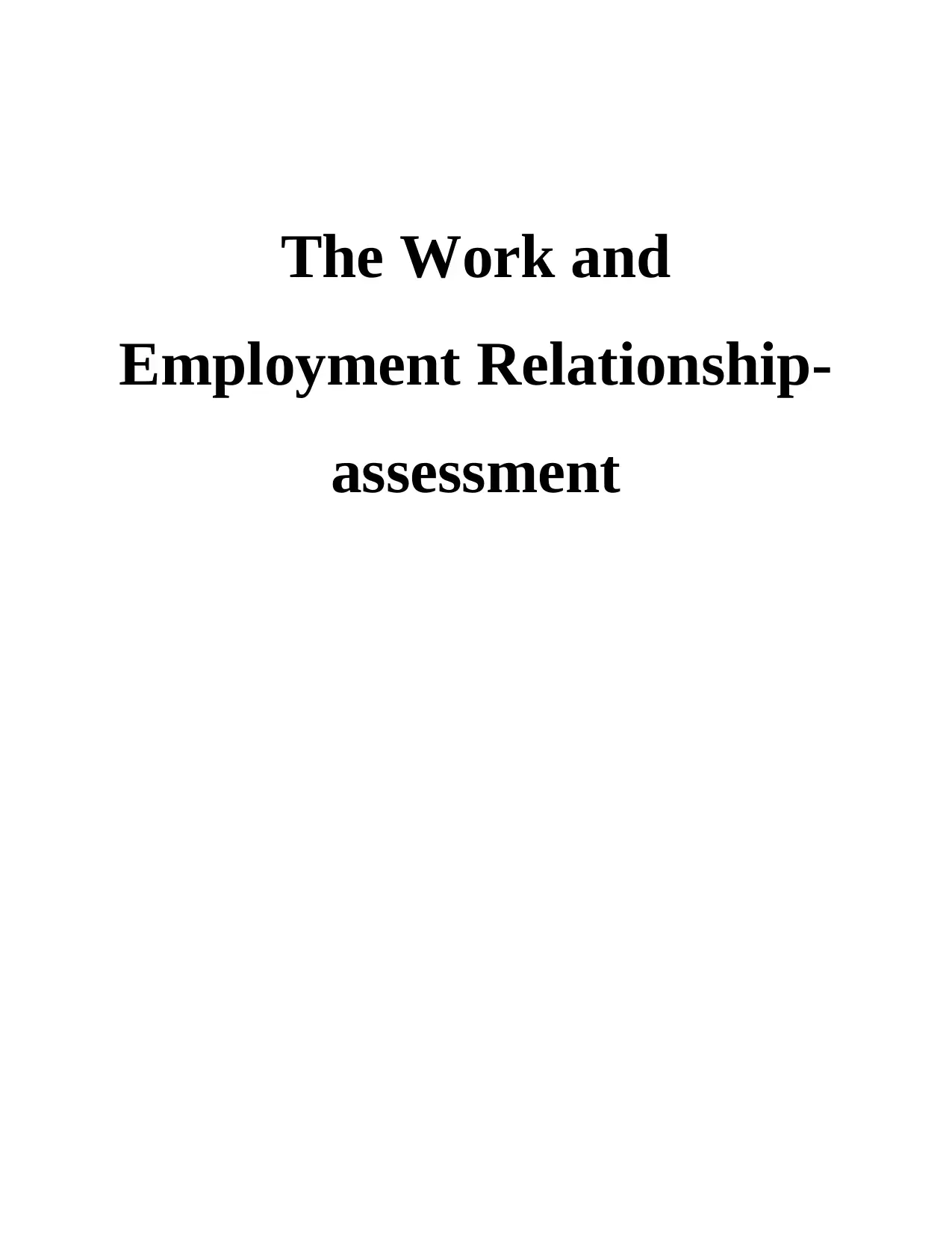
The Work and
Employment Relationship-
assessment
Employment Relationship-
assessment
Paraphrase This Document
Need a fresh take? Get an instant paraphrase of this document with our AI Paraphraser

Table of Contents
INTRODUCTION...........................................................................................................................3
MAIN BODY...................................................................................................................................3
1. An explanation of the value and importance of employee relations in application as well as
explanation of the fundamentals of employment law..................................................................3
2. An explanation of the different types of rights, duties and obligations an employer and
employee has within the workplace.............................................................................................5
3. A stakeholder analysis for the organisation and analysis of how stakeholder engagement and
contribution can support positive employment relationships......................................................7
4. An analysis of the impact of both positive and negative employee relations on different
stakeholders..................................................................................................................................8
CONCLUSION................................................................................................................................9
REFRENCES.................................................................................................................................10
INTRODUCTION...........................................................................................................................3
MAIN BODY...................................................................................................................................3
1. An explanation of the value and importance of employee relations in application as well as
explanation of the fundamentals of employment law..................................................................3
2. An explanation of the different types of rights, duties and obligations an employer and
employee has within the workplace.............................................................................................5
3. A stakeholder analysis for the organisation and analysis of how stakeholder engagement and
contribution can support positive employment relationships......................................................7
4. An analysis of the impact of both positive and negative employee relations on different
stakeholders..................................................................................................................................8
CONCLUSION................................................................................................................................9
REFRENCES.................................................................................................................................10

INTRODUCTION
Employment relation refer to the mutual obligation between the employee as well as
employer due to which overall organisation work in standard form to maintain the better
agreement between different parties. This programme is basically the part of human resource
strategy that help to maintain the interest of workforce due to the safe and healthy working
conditions, maintaining work life balance as well as pay and benefit (Countouris, 2016). For the
better understanding of report Tesco company has been selected which offer wide variety of
product and services like grocery items, availability of necessity as well as shopping items under
one roof. The company basically has the wide chains of retail stores as well as strong distribution
network that help to global serve the needs of people. This report cover topics like value as well
as importance of employee relation in the specific organisation. Describe different rights, duties
as well as obligations for both employer as well as employee within the organisation. Conduct
stakeholders analysis to engage the employee and support desirable employment relationship
within an organisation. Impact of both positive as well as negative employee relation within the
functioning of an organisation are covered in this report.
MAIN BODY
1. An explanation of the value and importance of employee relations in application as well as
explanation of the fundamentals of employment law
Employee relation is the prerequisite step that can help the organisation to build efficient
relationship amongst the different workforce of an organisation in order to maximise the
satisfaction as well as productivity. It generally helps the large organisation like Tesco to resolve
the personal issue as well as mitigate the chances associated with conflict among different
functional units to maintain the desirable environment and gain organisational success. Thus,
effective bond or relation generate the values in various ways that is defined below:
Value and importance of employee relations
Effective communication: To make the employees committed towards work the
employer of Tesco carry out communication on regular basis. This help to maintain the
transparency and clarity regarding objective within different levels of hierarchical position.
Along with that the company encourages employee to participate in the decision making and
barnstorming method which led them to maintain the job satisfaction as they feel that the
Employment relation refer to the mutual obligation between the employee as well as
employer due to which overall organisation work in standard form to maintain the better
agreement between different parties. This programme is basically the part of human resource
strategy that help to maintain the interest of workforce due to the safe and healthy working
conditions, maintaining work life balance as well as pay and benefit (Countouris, 2016). For the
better understanding of report Tesco company has been selected which offer wide variety of
product and services like grocery items, availability of necessity as well as shopping items under
one roof. The company basically has the wide chains of retail stores as well as strong distribution
network that help to global serve the needs of people. This report cover topics like value as well
as importance of employee relation in the specific organisation. Describe different rights, duties
as well as obligations for both employer as well as employee within the organisation. Conduct
stakeholders analysis to engage the employee and support desirable employment relationship
within an organisation. Impact of both positive as well as negative employee relation within the
functioning of an organisation are covered in this report.
MAIN BODY
1. An explanation of the value and importance of employee relations in application as well as
explanation of the fundamentals of employment law
Employee relation is the prerequisite step that can help the organisation to build efficient
relationship amongst the different workforce of an organisation in order to maximise the
satisfaction as well as productivity. It generally helps the large organisation like Tesco to resolve
the personal issue as well as mitigate the chances associated with conflict among different
functional units to maintain the desirable environment and gain organisational success. Thus,
effective bond or relation generate the values in various ways that is defined below:
Value and importance of employee relations
Effective communication: To make the employees committed towards work the
employer of Tesco carry out communication on regular basis. This help to maintain the
transparency and clarity regarding objective within different levels of hierarchical position.
Along with that the company encourages employee to participate in the decision making and
barnstorming method which led them to maintain the job satisfaction as they feel that the
⊘ This is a preview!⊘
Do you want full access?
Subscribe today to unlock all pages.

Trusted by 1+ million students worldwide
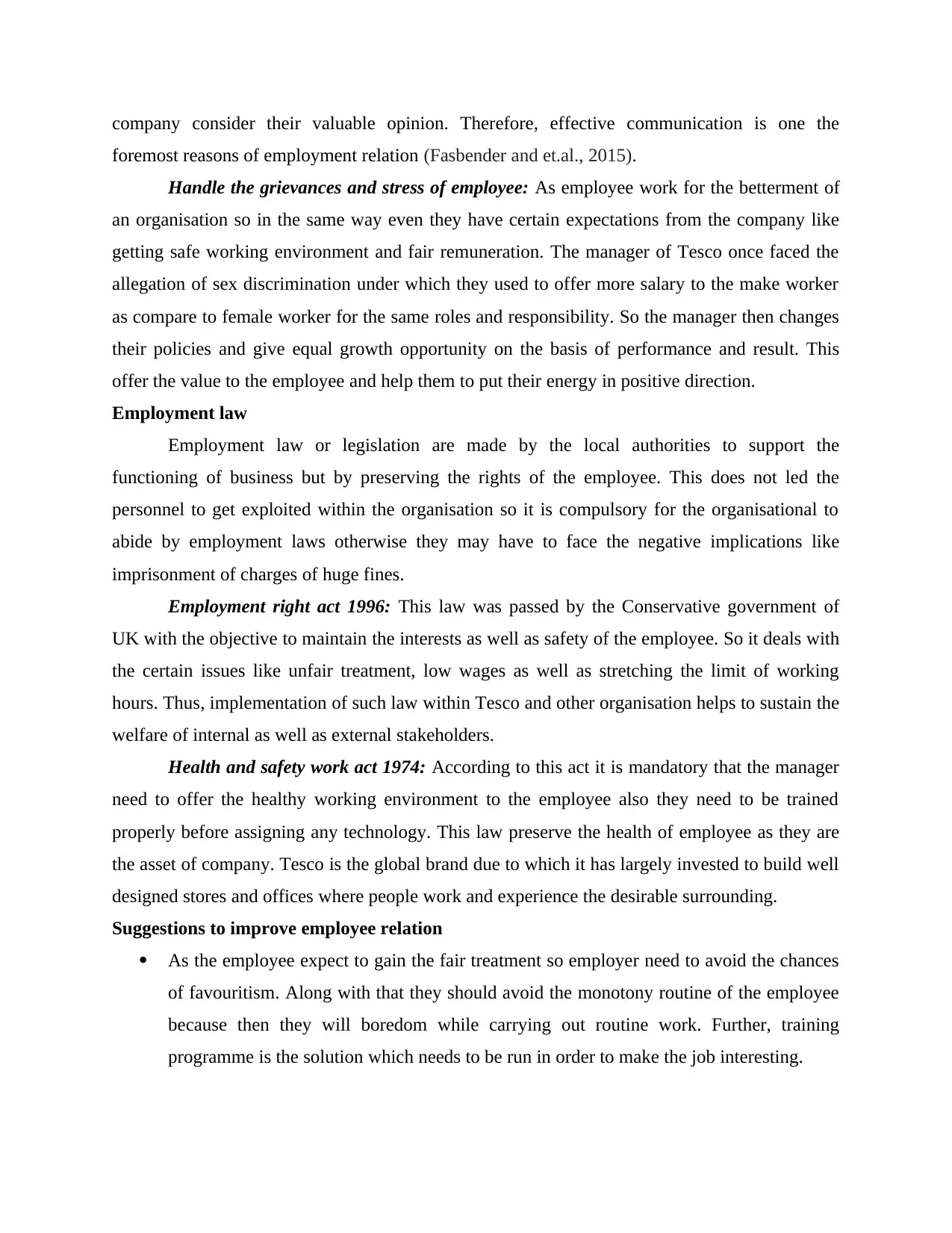
company consider their valuable opinion. Therefore, effective communication is one the
foremost reasons of employment relation (Fasbender and et.al., 2015).
Handle the grievances and stress of employee: As employee work for the betterment of
an organisation so in the same way even they have certain expectations from the company like
getting safe working environment and fair remuneration. The manager of Tesco once faced the
allegation of sex discrimination under which they used to offer more salary to the make worker
as compare to female worker for the same roles and responsibility. So the manager then changes
their policies and give equal growth opportunity on the basis of performance and result. This
offer the value to the employee and help them to put their energy in positive direction.
Employment law
Employment law or legislation are made by the local authorities to support the
functioning of business but by preserving the rights of the employee. This does not led the
personnel to get exploited within the organisation so it is compulsory for the organisational to
abide by employment laws otherwise they may have to face the negative implications like
imprisonment of charges of huge fines.
Employment right act 1996: This law was passed by the Conservative government of
UK with the objective to maintain the interests as well as safety of the employee. So it deals with
the certain issues like unfair treatment, low wages as well as stretching the limit of working
hours. Thus, implementation of such law within Tesco and other organisation helps to sustain the
welfare of internal as well as external stakeholders.
Health and safety work act 1974: According to this act it is mandatory that the manager
need to offer the healthy working environment to the employee also they need to be trained
properly before assigning any technology. This law preserve the health of employee as they are
the asset of company. Tesco is the global brand due to which it has largely invested to build well
designed stores and offices where people work and experience the desirable surrounding.
Suggestions to improve employee relation
As the employee expect to gain the fair treatment so employer need to avoid the chances
of favouritism. Along with that they should avoid the monotony routine of the employee
because then they will boredom while carrying out routine work. Further, training
programme is the solution which needs to be run in order to make the job interesting.
foremost reasons of employment relation (Fasbender and et.al., 2015).
Handle the grievances and stress of employee: As employee work for the betterment of
an organisation so in the same way even they have certain expectations from the company like
getting safe working environment and fair remuneration. The manager of Tesco once faced the
allegation of sex discrimination under which they used to offer more salary to the make worker
as compare to female worker for the same roles and responsibility. So the manager then changes
their policies and give equal growth opportunity on the basis of performance and result. This
offer the value to the employee and help them to put their energy in positive direction.
Employment law
Employment law or legislation are made by the local authorities to support the
functioning of business but by preserving the rights of the employee. This does not led the
personnel to get exploited within the organisation so it is compulsory for the organisational to
abide by employment laws otherwise they may have to face the negative implications like
imprisonment of charges of huge fines.
Employment right act 1996: This law was passed by the Conservative government of
UK with the objective to maintain the interests as well as safety of the employee. So it deals with
the certain issues like unfair treatment, low wages as well as stretching the limit of working
hours. Thus, implementation of such law within Tesco and other organisation helps to sustain the
welfare of internal as well as external stakeholders.
Health and safety work act 1974: According to this act it is mandatory that the manager
need to offer the healthy working environment to the employee also they need to be trained
properly before assigning any technology. This law preserve the health of employee as they are
the asset of company. Tesco is the global brand due to which it has largely invested to build well
designed stores and offices where people work and experience the desirable surrounding.
Suggestions to improve employee relation
As the employee expect to gain the fair treatment so employer need to avoid the chances
of favouritism. Along with that they should avoid the monotony routine of the employee
because then they will boredom while carrying out routine work. Further, training
programme is the solution which needs to be run in order to make the job interesting.
Paraphrase This Document
Need a fresh take? Get an instant paraphrase of this document with our AI Paraphraser
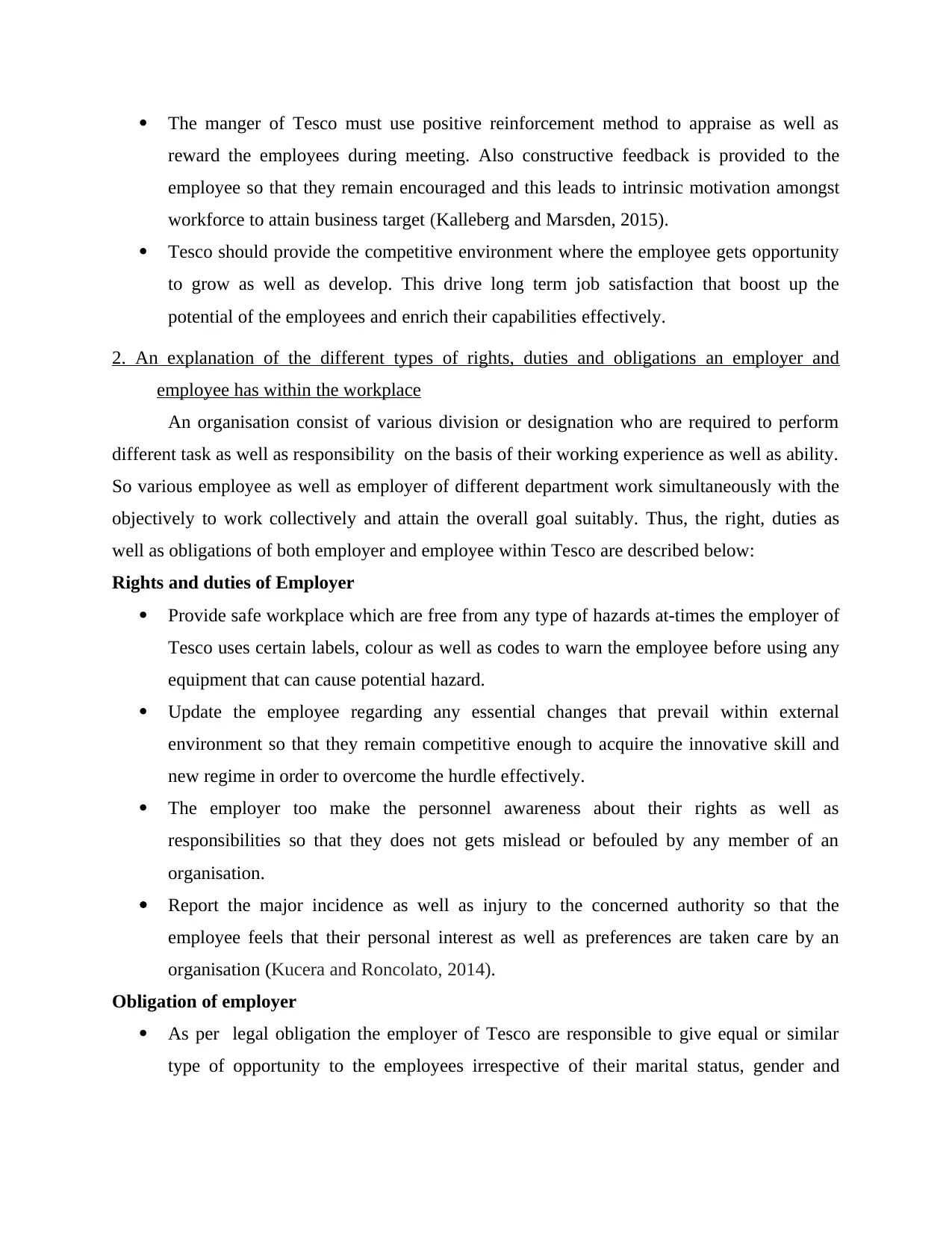
The manger of Tesco must use positive reinforcement method to appraise as well as
reward the employees during meeting. Also constructive feedback is provided to the
employee so that they remain encouraged and this leads to intrinsic motivation amongst
workforce to attain business target (Kalleberg and Marsden, 2015).
Tesco should provide the competitive environment where the employee gets opportunity
to grow as well as develop. This drive long term job satisfaction that boost up the
potential of the employees and enrich their capabilities effectively.
2. An explanation of the different types of rights, duties and obligations an employer and
employee has within the workplace
An organisation consist of various division or designation who are required to perform
different task as well as responsibility on the basis of their working experience as well as ability.
So various employee as well as employer of different department work simultaneously with the
objectively to work collectively and attain the overall goal suitably. Thus, the right, duties as
well as obligations of both employer and employee within Tesco are described below:
Rights and duties of Employer
Provide safe workplace which are free from any type of hazards at-times the employer of
Tesco uses certain labels, colour as well as codes to warn the employee before using any
equipment that can cause potential hazard.
Update the employee regarding any essential changes that prevail within external
environment so that they remain competitive enough to acquire the innovative skill and
new regime in order to overcome the hurdle effectively.
The employer too make the personnel awareness about their rights as well as
responsibilities so that they does not gets mislead or befouled by any member of an
organisation.
Report the major incidence as well as injury to the concerned authority so that the
employee feels that their personal interest as well as preferences are taken care by an
organisation (Kucera and Roncolato, 2014).
Obligation of employer
As per legal obligation the employer of Tesco are responsible to give equal or similar
type of opportunity to the employees irrespective of their marital status, gender and
reward the employees during meeting. Also constructive feedback is provided to the
employee so that they remain encouraged and this leads to intrinsic motivation amongst
workforce to attain business target (Kalleberg and Marsden, 2015).
Tesco should provide the competitive environment where the employee gets opportunity
to grow as well as develop. This drive long term job satisfaction that boost up the
potential of the employees and enrich their capabilities effectively.
2. An explanation of the different types of rights, duties and obligations an employer and
employee has within the workplace
An organisation consist of various division or designation who are required to perform
different task as well as responsibility on the basis of their working experience as well as ability.
So various employee as well as employer of different department work simultaneously with the
objectively to work collectively and attain the overall goal suitably. Thus, the right, duties as
well as obligations of both employer and employee within Tesco are described below:
Rights and duties of Employer
Provide safe workplace which are free from any type of hazards at-times the employer of
Tesco uses certain labels, colour as well as codes to warn the employee before using any
equipment that can cause potential hazard.
Update the employee regarding any essential changes that prevail within external
environment so that they remain competitive enough to acquire the innovative skill and
new regime in order to overcome the hurdle effectively.
The employer too make the personnel awareness about their rights as well as
responsibilities so that they does not gets mislead or befouled by any member of an
organisation.
Report the major incidence as well as injury to the concerned authority so that the
employee feels that their personal interest as well as preferences are taken care by an
organisation (Kucera and Roncolato, 2014).
Obligation of employer
As per legal obligation the employer of Tesco are responsible to give equal or similar
type of opportunity to the employees irrespective of their marital status, gender and
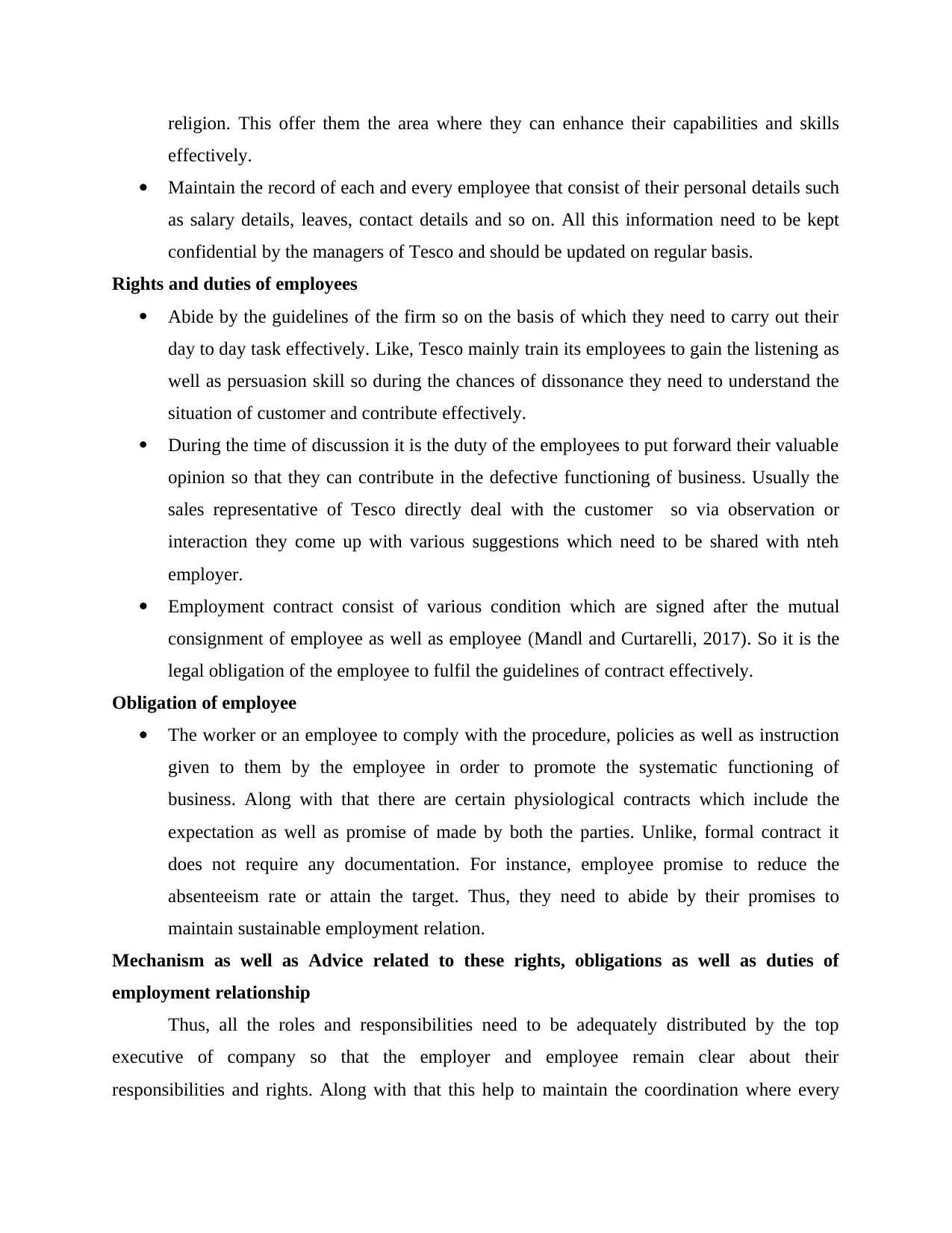
religion. This offer them the area where they can enhance their capabilities and skills
effectively.
Maintain the record of each and every employee that consist of their personal details such
as salary details, leaves, contact details and so on. All this information need to be kept
confidential by the managers of Tesco and should be updated on regular basis.
Rights and duties of employees
Abide by the guidelines of the firm so on the basis of which they need to carry out their
day to day task effectively. Like, Tesco mainly train its employees to gain the listening as
well as persuasion skill so during the chances of dissonance they need to understand the
situation of customer and contribute effectively.
During the time of discussion it is the duty of the employees to put forward their valuable
opinion so that they can contribute in the defective functioning of business. Usually the
sales representative of Tesco directly deal with the customer so via observation or
interaction they come up with various suggestions which need to be shared with nteh
employer.
Employment contract consist of various condition which are signed after the mutual
consignment of employee as well as employee (Mandl and Curtarelli, 2017). So it is the
legal obligation of the employee to fulfil the guidelines of contract effectively.
Obligation of employee
The worker or an employee to comply with the procedure, policies as well as instruction
given to them by the employee in order to promote the systematic functioning of
business. Along with that there are certain physiological contracts which include the
expectation as well as promise of made by both the parties. Unlike, formal contract it
does not require any documentation. For instance, employee promise to reduce the
absenteeism rate or attain the target. Thus, they need to abide by their promises to
maintain sustainable employment relation.
Mechanism as well as Advice related to these rights, obligations as well as duties of
employment relationship
Thus, all the roles and responsibilities need to be adequately distributed by the top
executive of company so that the employer and employee remain clear about their
responsibilities and rights. Along with that this help to maintain the coordination where every
effectively.
Maintain the record of each and every employee that consist of their personal details such
as salary details, leaves, contact details and so on. All this information need to be kept
confidential by the managers of Tesco and should be updated on regular basis.
Rights and duties of employees
Abide by the guidelines of the firm so on the basis of which they need to carry out their
day to day task effectively. Like, Tesco mainly train its employees to gain the listening as
well as persuasion skill so during the chances of dissonance they need to understand the
situation of customer and contribute effectively.
During the time of discussion it is the duty of the employees to put forward their valuable
opinion so that they can contribute in the defective functioning of business. Usually the
sales representative of Tesco directly deal with the customer so via observation or
interaction they come up with various suggestions which need to be shared with nteh
employer.
Employment contract consist of various condition which are signed after the mutual
consignment of employee as well as employee (Mandl and Curtarelli, 2017). So it is the
legal obligation of the employee to fulfil the guidelines of contract effectively.
Obligation of employee
The worker or an employee to comply with the procedure, policies as well as instruction
given to them by the employee in order to promote the systematic functioning of
business. Along with that there are certain physiological contracts which include the
expectation as well as promise of made by both the parties. Unlike, formal contract it
does not require any documentation. For instance, employee promise to reduce the
absenteeism rate or attain the target. Thus, they need to abide by their promises to
maintain sustainable employment relation.
Mechanism as well as Advice related to these rights, obligations as well as duties of
employment relationship
Thus, all the roles and responsibilities need to be adequately distributed by the top
executive of company so that the employer and employee remain clear about their
responsibilities and rights. Along with that this help to maintain the coordination where every
⊘ This is a preview!⊘
Do you want full access?
Subscribe today to unlock all pages.

Trusted by 1+ million students worldwide
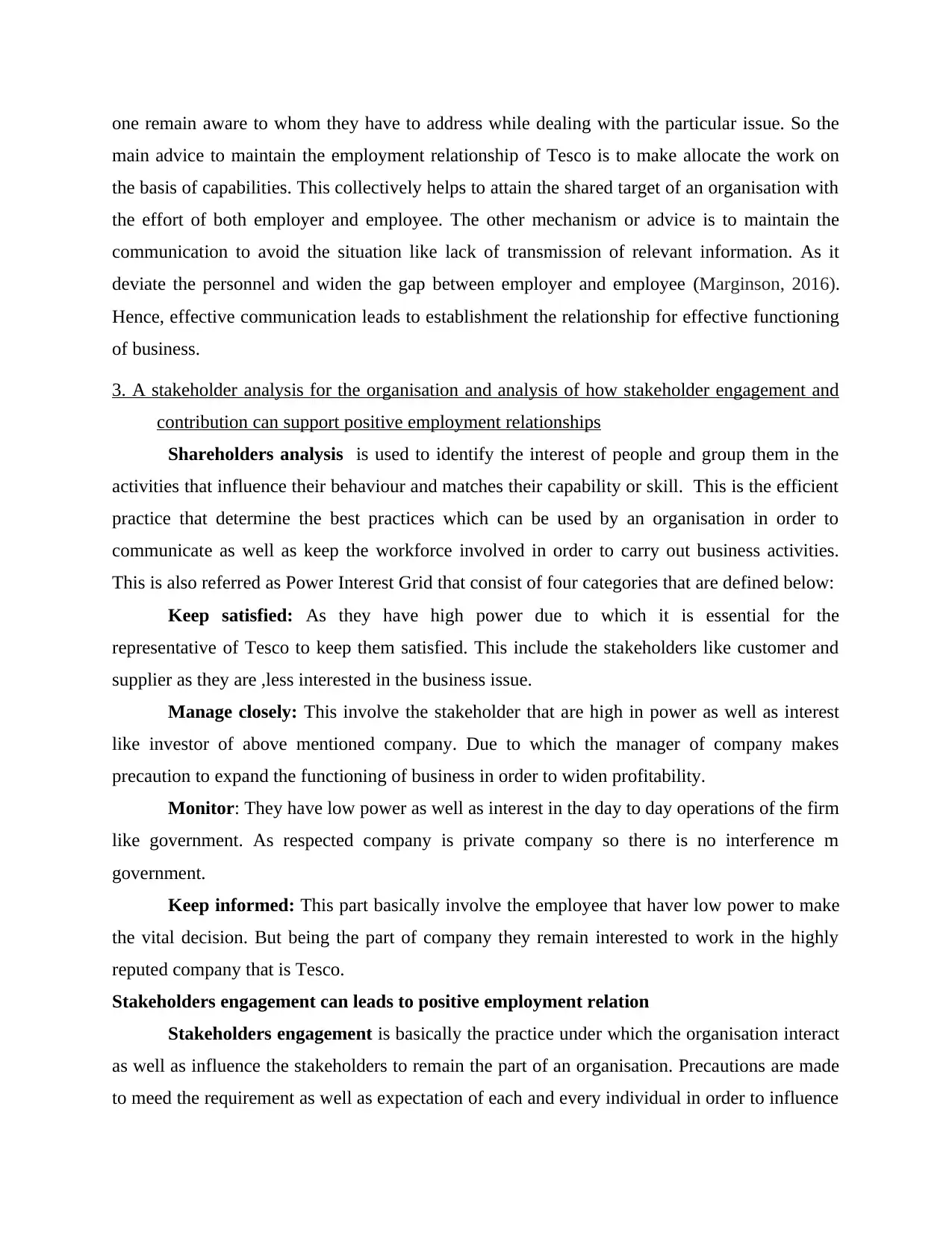
one remain aware to whom they have to address while dealing with the particular issue. So the
main advice to maintain the employment relationship of Tesco is to make allocate the work on
the basis of capabilities. This collectively helps to attain the shared target of an organisation with
the effort of both employer and employee. The other mechanism or advice is to maintain the
communication to avoid the situation like lack of transmission of relevant information. As it
deviate the personnel and widen the gap between employer and employee (Marginson, 2016).
Hence, effective communication leads to establishment the relationship for effective functioning
of business.
3. A stakeholder analysis for the organisation and analysis of how stakeholder engagement and
contribution can support positive employment relationships
Shareholders analysis is used to identify the interest of people and group them in the
activities that influence their behaviour and matches their capability or skill. This is the efficient
practice that determine the best practices which can be used by an organisation in order to
communicate as well as keep the workforce involved in order to carry out business activities.
This is also referred as Power Interest Grid that consist of four categories that are defined below:
Keep satisfied: As they have high power due to which it is essential for the
representative of Tesco to keep them satisfied. This include the stakeholders like customer and
supplier as they are ,less interested in the business issue.
Manage closely: This involve the stakeholder that are high in power as well as interest
like investor of above mentioned company. Due to which the manager of company makes
precaution to expand the functioning of business in order to widen profitability.
Monitor: They have low power as well as interest in the day to day operations of the firm
like government. As respected company is private company so there is no interference m
government.
Keep informed: This part basically involve the employee that haver low power to make
the vital decision. But being the part of company they remain interested to work in the highly
reputed company that is Tesco.
Stakeholders engagement can leads to positive employment relation
Stakeholders engagement is basically the practice under which the organisation interact
as well as influence the stakeholders to remain the part of an organisation. Precautions are made
to meed the requirement as well as expectation of each and every individual in order to influence
main advice to maintain the employment relationship of Tesco is to make allocate the work on
the basis of capabilities. This collectively helps to attain the shared target of an organisation with
the effort of both employer and employee. The other mechanism or advice is to maintain the
communication to avoid the situation like lack of transmission of relevant information. As it
deviate the personnel and widen the gap between employer and employee (Marginson, 2016).
Hence, effective communication leads to establishment the relationship for effective functioning
of business.
3. A stakeholder analysis for the organisation and analysis of how stakeholder engagement and
contribution can support positive employment relationships
Shareholders analysis is used to identify the interest of people and group them in the
activities that influence their behaviour and matches their capability or skill. This is the efficient
practice that determine the best practices which can be used by an organisation in order to
communicate as well as keep the workforce involved in order to carry out business activities.
This is also referred as Power Interest Grid that consist of four categories that are defined below:
Keep satisfied: As they have high power due to which it is essential for the
representative of Tesco to keep them satisfied. This include the stakeholders like customer and
supplier as they are ,less interested in the business issue.
Manage closely: This involve the stakeholder that are high in power as well as interest
like investor of above mentioned company. Due to which the manager of company makes
precaution to expand the functioning of business in order to widen profitability.
Monitor: They have low power as well as interest in the day to day operations of the firm
like government. As respected company is private company so there is no interference m
government.
Keep informed: This part basically involve the employee that haver low power to make
the vital decision. But being the part of company they remain interested to work in the highly
reputed company that is Tesco.
Stakeholders engagement can leads to positive employment relation
Stakeholders engagement is basically the practice under which the organisation interact
as well as influence the stakeholders to remain the part of an organisation. Precautions are made
to meed the requirement as well as expectation of each and every individual in order to influence
Paraphrase This Document
Need a fresh take? Get an instant paraphrase of this document with our AI Paraphraser
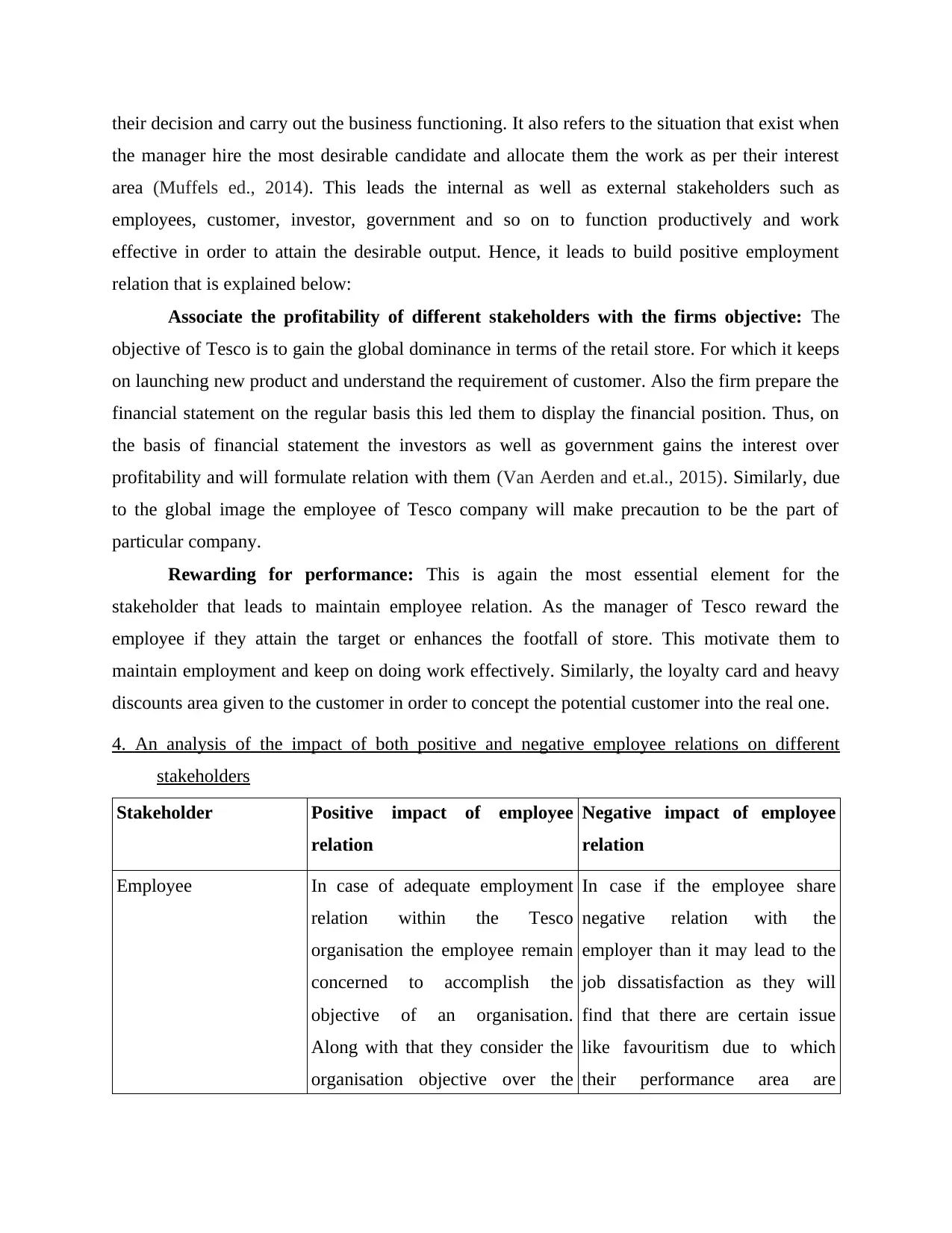
their decision and carry out the business functioning. It also refers to the situation that exist when
the manager hire the most desirable candidate and allocate them the work as per their interest
area (Muffels ed., 2014). This leads the internal as well as external stakeholders such as
employees, customer, investor, government and so on to function productively and work
effective in order to attain the desirable output. Hence, it leads to build positive employment
relation that is explained below:
Associate the profitability of different stakeholders with the firms objective: The
objective of Tesco is to gain the global dominance in terms of the retail store. For which it keeps
on launching new product and understand the requirement of customer. Also the firm prepare the
financial statement on the regular basis this led them to display the financial position. Thus, on
the basis of financial statement the investors as well as government gains the interest over
profitability and will formulate relation with them (Van Aerden and et.al., 2015). Similarly, due
to the global image the employee of Tesco company will make precaution to be the part of
particular company.
Rewarding for performance: This is again the most essential element for the
stakeholder that leads to maintain employee relation. As the manager of Tesco reward the
employee if they attain the target or enhances the footfall of store. This motivate them to
maintain employment and keep on doing work effectively. Similarly, the loyalty card and heavy
discounts area given to the customer in order to concept the potential customer into the real one.
4. An analysis of the impact of both positive and negative employee relations on different
stakeholders
Stakeholder Positive impact of employee
relation
Negative impact of employee
relation
Employee In case of adequate employment
relation within the Tesco
organisation the employee remain
concerned to accomplish the
objective of an organisation.
Along with that they consider the
organisation objective over the
In case if the employee share
negative relation with the
employer than it may lead to the
job dissatisfaction as they will
find that there are certain issue
like favouritism due to which
their performance area are
the manager hire the most desirable candidate and allocate them the work as per their interest
area (Muffels ed., 2014). This leads the internal as well as external stakeholders such as
employees, customer, investor, government and so on to function productively and work
effective in order to attain the desirable output. Hence, it leads to build positive employment
relation that is explained below:
Associate the profitability of different stakeholders with the firms objective: The
objective of Tesco is to gain the global dominance in terms of the retail store. For which it keeps
on launching new product and understand the requirement of customer. Also the firm prepare the
financial statement on the regular basis this led them to display the financial position. Thus, on
the basis of financial statement the investors as well as government gains the interest over
profitability and will formulate relation with them (Van Aerden and et.al., 2015). Similarly, due
to the global image the employee of Tesco company will make precaution to be the part of
particular company.
Rewarding for performance: This is again the most essential element for the
stakeholder that leads to maintain employee relation. As the manager of Tesco reward the
employee if they attain the target or enhances the footfall of store. This motivate them to
maintain employment and keep on doing work effectively. Similarly, the loyalty card and heavy
discounts area given to the customer in order to concept the potential customer into the real one.
4. An analysis of the impact of both positive and negative employee relations on different
stakeholders
Stakeholder Positive impact of employee
relation
Negative impact of employee
relation
Employee In case of adequate employment
relation within the Tesco
organisation the employee remain
concerned to accomplish the
objective of an organisation.
Along with that they consider the
organisation objective over the
In case if the employee share
negative relation with the
employer than it may lead to the
job dissatisfaction as they will
find that there are certain issue
like favouritism due to which
their performance area are

personal objective because they
know that their employer will
consider their effort. Die to which
they make all possible efforts and
laid to reduce chances of turnover
as well absenteeism rate (Suleman,
2014).
appraised. This demotivate the
employee and affect the internal
atmosphere of company by rising
concern which are related with
huge gap between the actual and
standard performance, lack of
coordination among different
teams, negative politics as well as
emergence of internal conflict.
Customer Customer are one of the most
essential stakeholders of company
as they help to generate revenue
for company. So if they feel that
the organisation serve them the
quality product and cater their
changing requirement then this can
lead them to remain loyal towards
the company.
Due to the immense competition
and large availability of the
substitute if the customer find
that the organisation lack to cater
their demand and does not
consider the valuable opinion
then lack of adequate relation can
instigate the customer to switch
other rivalries of the same
industry (Wright and Kaine,
2015).
CONCLUSION
From above report it has been concluded that employment relation basically deliver the
high value to the internal stakeholder of company that is employee in order to fulfil the
organisational objective. Employment relation is the prominent part of the organisation that
sustain the interrelationship between employer and employer. This together led them to attain the
organisational objective significantly. So the organisation need to maintain the communication
with different stakeholders in order to overcome the certain issue like rising conflict or chaos. As
better understanding helps the organisation to replace the internal competition with cooperation
in order to attain sustainable objective.
know that their employer will
consider their effort. Die to which
they make all possible efforts and
laid to reduce chances of turnover
as well absenteeism rate (Suleman,
2014).
appraised. This demotivate the
employee and affect the internal
atmosphere of company by rising
concern which are related with
huge gap between the actual and
standard performance, lack of
coordination among different
teams, negative politics as well as
emergence of internal conflict.
Customer Customer are one of the most
essential stakeholders of company
as they help to generate revenue
for company. So if they feel that
the organisation serve them the
quality product and cater their
changing requirement then this can
lead them to remain loyal towards
the company.
Due to the immense competition
and large availability of the
substitute if the customer find
that the organisation lack to cater
their demand and does not
consider the valuable opinion
then lack of adequate relation can
instigate the customer to switch
other rivalries of the same
industry (Wright and Kaine,
2015).
CONCLUSION
From above report it has been concluded that employment relation basically deliver the
high value to the internal stakeholder of company that is employee in order to fulfil the
organisational objective. Employment relation is the prominent part of the organisation that
sustain the interrelationship between employer and employer. This together led them to attain the
organisational objective significantly. So the organisation need to maintain the communication
with different stakeholders in order to overcome the certain issue like rising conflict or chaos. As
better understanding helps the organisation to replace the internal competition with cooperation
in order to attain sustainable objective.
⊘ This is a preview!⊘
Do you want full access?
Subscribe today to unlock all pages.

Trusted by 1+ million students worldwide
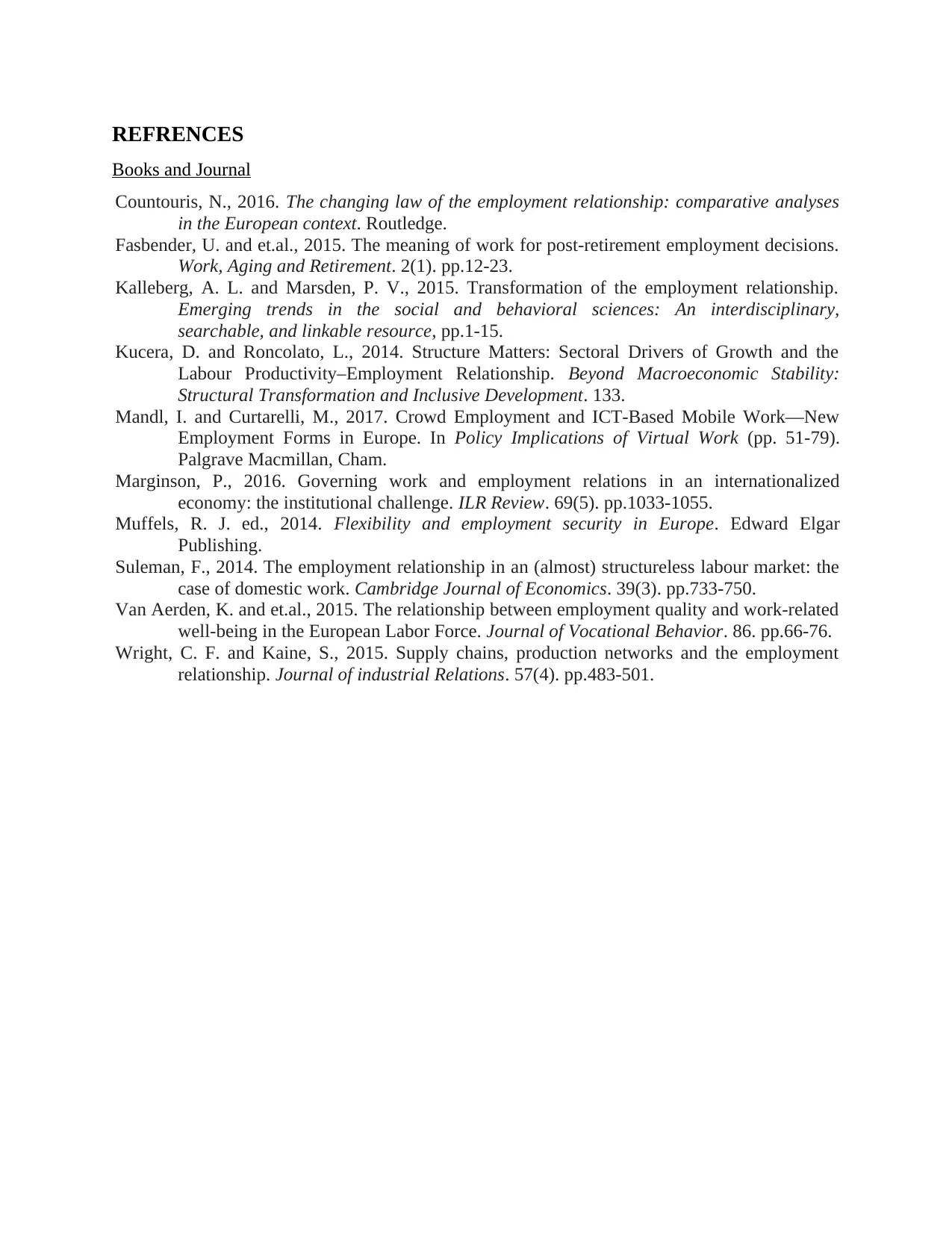
REFRENCES
Books and Journal
Countouris, N., 2016. The changing law of the employment relationship: comparative analyses
in the European context. Routledge.
Fasbender, U. and et.al., 2015. The meaning of work for post-retirement employment decisions.
Work, Aging and Retirement. 2(1). pp.12-23.
Kalleberg, A. L. and Marsden, P. V., 2015. Transformation of the employment relationship.
Emerging trends in the social and behavioral sciences: An interdisciplinary,
searchable, and linkable resource, pp.1-15.
Kucera, D. and Roncolato, L., 2014. Structure Matters: Sectoral Drivers of Growth and the
Labour Productivity–Employment Relationship. Beyond Macroeconomic Stability:
Structural Transformation and Inclusive Development. 133.
Mandl, I. and Curtarelli, M., 2017. Crowd Employment and ICT-Based Mobile Work—New
Employment Forms in Europe. In Policy Implications of Virtual Work (pp. 51-79).
Palgrave Macmillan, Cham.
Marginson, P., 2016. Governing work and employment relations in an internationalized
economy: the institutional challenge. ILR Review. 69(5). pp.1033-1055.
Muffels, R. J. ed., 2014. Flexibility and employment security in Europe. Edward Elgar
Publishing.
Suleman, F., 2014. The employment relationship in an (almost) structureless labour market: the
case of domestic work. Cambridge Journal of Economics. 39(3). pp.733-750.
Van Aerden, K. and et.al., 2015. The relationship between employment quality and work-related
well-being in the European Labor Force. Journal of Vocational Behavior. 86. pp.66-76.
Wright, C. F. and Kaine, S., 2015. Supply chains, production networks and the employment
relationship. Journal of industrial Relations. 57(4). pp.483-501.
Books and Journal
Countouris, N., 2016. The changing law of the employment relationship: comparative analyses
in the European context. Routledge.
Fasbender, U. and et.al., 2015. The meaning of work for post-retirement employment decisions.
Work, Aging and Retirement. 2(1). pp.12-23.
Kalleberg, A. L. and Marsden, P. V., 2015. Transformation of the employment relationship.
Emerging trends in the social and behavioral sciences: An interdisciplinary,
searchable, and linkable resource, pp.1-15.
Kucera, D. and Roncolato, L., 2014. Structure Matters: Sectoral Drivers of Growth and the
Labour Productivity–Employment Relationship. Beyond Macroeconomic Stability:
Structural Transformation and Inclusive Development. 133.
Mandl, I. and Curtarelli, M., 2017. Crowd Employment and ICT-Based Mobile Work—New
Employment Forms in Europe. In Policy Implications of Virtual Work (pp. 51-79).
Palgrave Macmillan, Cham.
Marginson, P., 2016. Governing work and employment relations in an internationalized
economy: the institutional challenge. ILR Review. 69(5). pp.1033-1055.
Muffels, R. J. ed., 2014. Flexibility and employment security in Europe. Edward Elgar
Publishing.
Suleman, F., 2014. The employment relationship in an (almost) structureless labour market: the
case of domestic work. Cambridge Journal of Economics. 39(3). pp.733-750.
Van Aerden, K. and et.al., 2015. The relationship between employment quality and work-related
well-being in the European Labor Force. Journal of Vocational Behavior. 86. pp.66-76.
Wright, C. F. and Kaine, S., 2015. Supply chains, production networks and the employment
relationship. Journal of industrial Relations. 57(4). pp.483-501.
1 out of 10
Related Documents
Your All-in-One AI-Powered Toolkit for Academic Success.
+13062052269
info@desklib.com
Available 24*7 on WhatsApp / Email
![[object Object]](/_next/static/media/star-bottom.7253800d.svg)
Unlock your academic potential
Copyright © 2020–2025 A2Z Services. All Rights Reserved. Developed and managed by ZUCOL.





